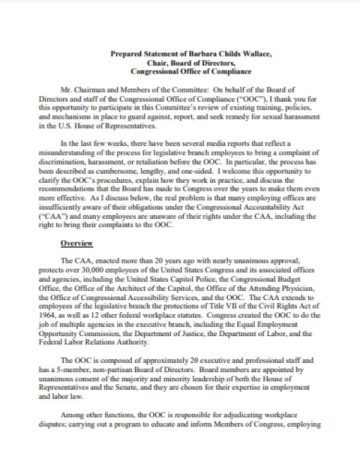Mr. Chairman and Members of the Committee: On behalf of the Board of Directors and staff of the Congressional Office of Compliance (“OOC”), I thank you for this opportunity to participate in this Committee’s review of existing training, policies, and mechanisms in place to guard against, report, and seek remedy for sexual harassment in the U.S. House of Representatives.
In the last few weeks, there have been several media reports that reflect a misunderstanding of the process for legislative branch employees to bring a complaint of discrimination, harassment, or retaliation before the OOC. In particular, the process has been described as cumbersome, lengthy, and one-sided. I welcome this opportunity to clarify the OOC’s procedures, explain how they work in practice, and discuss the recommendations that the Board has made to Congress over the years to make them even more effective. As I discuss below, the real problem is that many employing offices are insufficiently aware of their obligations under the Congressional Accountability Act (“CAA”) and many employees are unaware of their rights under the CAA, including the right to bring their complaints to the OOC.
Overview
The CAA, enacted more than 20 years ago with nearly unanimous approval, protects over 30,000 employees of the United States Congress and its associated offices and agencies, including the United States Capitol Police, the Congressional Budget Office, the Office of the Architect of the Capitol, the Office of the Attending Physician, the Office of Congressional Accessibility Services, and the OOC. The CAA extends to employees of the legislative branch the protections of Title VII of the Civil Rights Act of 1964, as well as 12 other federal workplace statutes. Congress created the OOC to do the job of multiple agencies in the executive branch, including the Equal Employment Opportunity Commission, the Department of Justice, the Department of Labor, and the Federal Labor Relations Authority.

